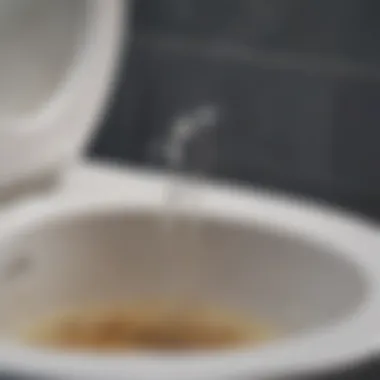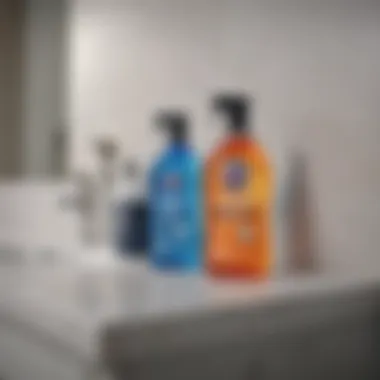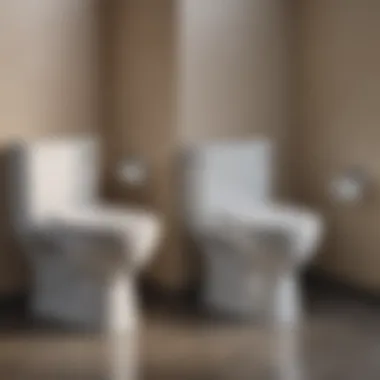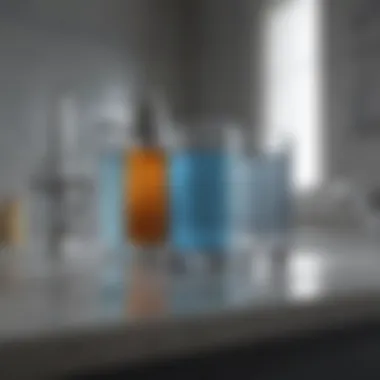Erase Toilet Stains: Ultimate Hard Water Guide


Intro
Hard water stains in toilets can be an unsightly nuisance for homeowners. They stem from various minerals like calcium and magnesium present in the water supply. Over time, these minerals accumulate, creating stains and unsightly discoloration. Not only do these marks impact the aesthetic appeal of your bathroom, but they could also hint at potential water quality issues. Understanding the causes of hard water stains is essential in developing effective cleaning strategies. This article aims to guide you through the removal process, prevention techniques, and the broader implications of maintaining proper water quality within your home.
Design Inspiration
Designing a bathroom that is both functional and visually appealing requires attention to details, even when it comes to maintenance challenges like hard water stains. Effective design should prioritize easy cleaning while minimizing staining potential.
Trending Styles
In recent years, minimalist designs have gained popularity. Such spaces with sleek lines and fewer embellishments can emphasize cleanliness. Furthermore, choosing high-quality ceramic or porcelain fixtures helps prevent staining. Additionally, opting for soft-close toilet seats can reduce wear and tear, enhancing longevity. Another consideration is choosing fixtures with finishes that resist mineral buildup, such as brushed nickel or chrome.
Color Palettes
Soft, neutral colors can help in masking any hard water stains that do occur. Shades like light gray, beige, or pastels can create a calming effect while also making any discoloration less glaring. When paired with proper lighting, these colors can elevate the overall aesthetic while maintaining a practical approach to bathroom design.
Practical Tips
Maintaining a clean toilet and preventing hard water stains requires ongoing effort, but simple actions can go a long way.
Maintenance & Care
Regular cleaning is crucial in combating hard water stains. It is advisable to incorporate a routine that includes:
- Using a specialized toilet cleaner designed for mineral buildup.
- Scrubbing the toilet bowl weekly with a toilet brush.
- Considering the use of a pumice stone for stubborn stains, but ensuring the toilet surface is safe before application.
Incorporating preventative measures is also important. Installing a water softener can greatly reduce the mineral content of the water supply, limiting future staining. Furthermore, flushing the toilet regularly can help maintain cleanliness.
Budgeting & Planning
When approaching toilet maintenance, budgeting for cleaning supplies is essential. Products like CLR (Calcium, Lime, and Rust Remover) or vinegar-based cleaners are affordable choices. Plan for additional future costs if considering water softener systems. Investigating local plumbing services or DIY options might lead to effective solutions for your home. Doing research ahead of time can save money and provide a clearer understanding of options available.
"Maintaining a clean toilet starts with understanding the root causes of stains and implementing a consistent cleaning routine."
By following these outlined strategies, homeowners can not only remove tough stains but also enhance the overall cleanliness and appearance of their bathrooms.
Understanding Hard Water and Its Effects on Toilets
To fully tackle the issue of toilet stains caused by hard water, it is essential to understand the nature of hard water itself and how it interacts with various bathroom surfaces. This section elucidates the core characteristics of hard water and its consequential effects on toilets, preparing readers to approach the problem effectively. Understanding these aspects not only helps in addressing the stains but also offers insights into potential plumbing and maintenance issues.
What is Hard Water?
Hard water refers to water that contains a high concentration of dissolved minerals, primarily calcium and magnesium. This occurs when water passes over limestone or chalk deposits, which dissolve into the water supply. Hard water is prevalent in many areas and poses specific challenges in the home. While it is generally safe for consumption, its effects on plumbing systems, including toilets, can be significant.
Key Characteristics of Hard Water:
- Mineral Content: High levels of calcium and magnesium.
- Taste and Quality: Some may find it has a noticeable taste compared to soft water.
- Effect on Cleaning: Hard water tends to leave soap scum and mineral deposits.
Recognizing hard water is the first step in managing its effects on your home.
How Hard Water Causes Toilet Stains
The relationship between hard water and toilet stains is direct and notable. As hard water enters the toilet, it leaves behind mineral deposits as it evaporates. Over time, these deposits build up, forming stubborn stains that can be unsightly and difficult to remove.
Mechanism of Stain Formation:
- Evaporation: Water evaporates after flushing or leaks, leaving minerals.
- Repetition: Frequent use reinforces mineral deposits.
- Coloration: Stains may appear yellow or brown, influenced by other factors like rust or waste.
Addressing these stains requires knowledge of their origins, which is crucial for devising effective cleaning strategies.


Common Types of Stains
Toilet stains typically fall into a few categories, driven by the underlying water quality and composition. Understanding these variations helps in choosing the right cleaning approach.
Types of Stains:
- Lime Scale: Hard, white, chalky deposits that form in rings or along the water line.
- Rust Stains: Brownish-red coloration caused by iron in the water supply.
- Biofilm Stains: Dark brown or green stains, often caused by bacteria that thrive in damp environments.
These stains vary not only in their appearance but also in their origins, which influences how each should be treated effectively.
"Understanding the nature of hard water is key in preventing and treating stains effectively."
In summary, grasping the concepts surrounding hard water and its implications on toilets arms homeowners with the knowledge they need to confront and manage toilet stains. This understanding is foundational as it leads us toward identifying the stains and exploring practical solutions.
Identifying Hard Water Stains
Identifying hard water stains is crucial for maintaining the cleanliness and hygiene of your bathroom. Understanding these stains can lead to effective cleaning strategies, saving time and resources. Hard water contains high levels of minerals like calcium and magnesium, which leave deposits, often appearing as unsightly stains in toilets. Recognizing these stains not only helps in immediate cleaning but also indicates the quality of your water source. Accurate identification can prevent further complications linked to plumbing and water quality.
Visual Inspection Techniques
Visual inspection is one of the simplest yet effective methods to identify hard water stains. Start by assessing the toilet bowl and surrounding areas. Look for light brown, yellow, or white deposits. The texture is often rough compared to the smooth ceramic of the toilet. Pay attention to areas below the water line; stains tend to accumulate here, directly where the water sits frequently.
To enhance your processing of these stains:
- Observe color differences in the bowl after flushing; hard water stains show persistence.
- Check for rough spots which can be felt with your finger, indicating mineral build-up.
This inspection should become a routine part of hygiene checks. Understanding where and how stains form allows for proactive cleaning before they become entrenched.
Using Testing Kits for Water Quality
For a more scientific approach, using testing kits can thoroughly identify water quality issues leading to hard water stains. These kits measure mineral content in your water, revealing levels of hardness. They are widely available in home improvement stores or online.
To utilize a water testing kit effectively:
- Follow the instructions in the kit carefully. Typically, you will collect a water sample in a provided test vial.
- Add the test solutions as directed. The chemical reactions will indicate mineral levels through color changes.
- Compare the results to the included chart to determine the hardness level.
Understanding the mineral levels can guide future actions like installing a water softener if necessary. Regular testing ensures a long-term handle on water quality and its influence on fixtures, saving headaches down the road.
Tools and Supplies for Cleaning
The issue of hard water stains in toilets can be somewhat overwhelming for homeowners. Identifying the correct tools and cleaning supplies is vital in addressing these stubborn stains effectively. Over the years, the right combination of tools and supplies can make a significant difference in maintaining a clean and healthy bathroom environment. When looking at effective cleaning methods, understanding the importance of using high-quality products and tools is essential.
Essential Cleaning Products
Choosing the right cleaning products is crucial. Different products serve specific purposes based on their chemical compositions. Here are some common products used to tackle hard water stains:
- White vinegar: This natural acid is an effective solution for breaking down mineral deposits. It’s also safe to use in your toilet.
- Baking soda: Known for its deodorizing properties, baking soda helps scrub away stains when mixed with vinegar. It can lift grime without scratching surfaces.
- Borax: Another useful product, borax can boost the cleaning properties of bleach. It helps in removing tougher stains.
- Commercial toilet cleaners: Many brands offer formulations specifically designed for hard water stains. These products often contain stronger acids.
It’s essential to consider the safety of the products. Reading labels and ensuring that they do not contain harsh chemicals can prevent potential damage to plumbing.
Recommended Tools
The right tools are just as important as the cleaning products themselves. Here are some recommended tools which can make your cleaning efforts more efficient:
- Toilet brush: A sturdy toilet brush is critical. Look for one with durable bristles that can reach under the rim and scrub effectively.
- Scrub pads or sponges: These can be useful for stubborn stains. Ensure they are non-scratch to protect the porcelain surface.
- Pumice stone: A pumice stone can be very effective against heavy mineral buildup. It is gentle yet abrasive enough to remove tough stains.
- Protective gloves: Wearing gloves is important for hygiene and protecting your hands from harsh chemicals.
- Spray bottles: Ideal for applying vinegar or other solutions evenly. They can also help minimize the mess while cleaning.
Using quality tools will help increase the effectiveness of your cleaning routine. Investing time in understanding which supplies work best for your situation can lead to better results, maintaining a stain-free toilet for longer.
Effective Cleaning Methods


In addressing hard water stains in toilets, effective cleaning methods are crucial. These methods not only help in restoring the appearance of bathroom fixtures but also contribute to maintaining overall hygiene. By understanding these cleaning techniques, homeowners can select the best approach for their situation, ensuring that toilets remain clean and free from stains. This section explores various alternatives for removing hard water stains effectively, presenting both natural solutions and commercially available cleaners while emphasizing a step-by-step cleaning process.
Natural Cleaning Solutions
Natural cleaning solutions offer a gentle yet effective way to tackle hard water stains without harsh chemicals. When considering alternatives to commercial products, many homeowners prefer options that are eco-friendly and safe for frequent use.
- Vinegar: Acetic acid in vinegar breaks down mineral deposits. Pouring a cup of vinegar into the toilet bowl and letting it sit for an hour can significantly reduce stains.
- Baking Soda: Baking soda is mildly abrasive. Mixing it with vinegar creates a fizzing action that can lift stains effectively. Sprinkle some baking soda in the toilet, add vinegar, and flush after several minutes.
- Borax: This compound is useful for cleaning. Adding Borax to the toilet bowl, letting it dissolve, and then scrubbing can remove tough stains.
- Lemon Juice: The citric acid in lemon juice can also help. It is safe and effective for periodic cleaning of toilet stains, although it may require more frequent application.
Natural solutions may take a bit longer to work, but they minimize risks to plumbing and the environment. They also ensure that your cleaning methods are as safe as possible for everyone in the household.
Commercial Cleaners: Pros and Cons
Commercial cleaners are readily available and designed to combat hard water stains. While they can be effective, it is essential to weigh their pros and cons before use.
Pros:
- Effectiveness: Many commercial products are specifically formulated to tackle hard water stains and can deliver quick results.
- Convenience: They are easy to use and often come with ready-to-apply designs, saving time in cleaning efforts.
- Variety: There are numerous brands and types, from gels to sprays, allowing for a catered choice based on personal preference.
Cons:
- Health Concerns: Some commercial cleaners contain harsh chemicals that can pose health risks, especially in enclosed spaces.
- Environmental Impact: Many contain ingredients that may harm the environment. Homeowners should consider their long-term effect.
- Cost: High-quality cleaners can get expensive, especially if used frequently.
Choosing a cleaner that strikes the right balance between effectiveness and safety is crucial in maintaining a clean toilet while being mindful of health and environmental repercussions.
Step-by-Step Cleaning Process
To ensure a thorough cleaning of hard water stains, following a detailed step-by-step process can be beneficial. Here is a systematic approach:
- Preparation: Gather all cleaning supplies, including gloves, scrubbing brush, chosen cleaning solution, and cloths. Make sure to ventilate the bathroom to minimize chemical exposure.
- Initial Rinse: Start by flushing the toilet to remove debris. This step gives a clearer view of the stains that need attention.
- Apply Cleaner: Use your preferred natural or commercial cleaning solution. Ensure it covers the stains adequately. For natural solutions, allow time to soak.
- Scrub: Utilize a toilet brush to scrub the stains gently. Pay attention to areas where stains seem more stubborn, as these require more effort.
- Final Rinse: After scrubbing, flush the toilet to wash away the cleaner and any dislodged mineral deposits.
- Inspect: After cleaning, take a moment to inspect the toilet for remaining stains. If necessary, repeat the process for any stains that persist.
- Regular Maintenance: Incorporate this cleaning method into your routine to prevent future build-up of hard water stains.
Adhering to a systematic cleaning process can enhance the effectiveness of the cleaning method while promoting a healthier bathroom environment.
Preventive Measures for Stains
Preventive measures are key to combating the formation of hard water stains in toilets. Taking proactive steps can significantly reduce the frequency and severity of these stains. By implementing a well-thought-out routine, homeowners can maintain the aesthetic appeal of their bathrooms while minimizing cleaning efforts. Such measures offer various benefits, including saving time and resources, as well as preventing damage to plumbing systems. Let's explore some valuable strategies.
Regular Maintenance Tips
Regular maintenance is the cornerstone of preventing hard water stains. Here are some practical tips that one can follow:
- Clean Regularly: Schedule routine cleanings at least once every week. This prevents buildup and minimizes staining. Using a toilet brush, scrub the sides and under the rim with a suitable cleaner designed for hard water.
- Inspect Water Supply: Check the water source for any changes. If the water quality worsens, this could lead to more staining.
- Keep Toilet Lid Closed: This helps in reducing the evaporation of water which can concentrate minerals, forming stains. Closing the lid might seem simple, but it has a positive effect on cleanliness.
- Use Toilet Tank Tablets: Occasionally placing tablets designed to prevent stains in the toilet tank can help in reducing mineral buildup. However, be cautious to choose non-corrosive options to avoid damage.
By following these tips, homeowners can effectively manage their toilet cleanliness and extend the life of their fixtures.
Water Softening Options
For those living in areas with hard water issues, investing in water softening solutions may be beneficial. Here are some options:
- Ion Exchange Softeners: These systems exchange ions in hard water with sodium ions, softening the water. This effectively reduces calcium and magnesium deposits, which are the primary culprits of stains.
- Reverse Osmosis Systems: These systems filter out impurities and minerals, providing clean water that is less likely to cause stains.
- Conditioners: Some systems can condition hard water without removing minerals. They alter the molecular structure, preventing scale buildup while still retaining beneficial minerals.
Each of these options has its own merits and can be selected based on specific needs and budget.
In summary, preventive measures against hard water stains focus on routine cleaning and possibly incorporating water softening systems. These choices provide a streamlined approach for homeowners aiming to maintain a clean and pleasant toilet environment.
Health Implications of Hard Water
Understanding the health implications of hard water is essential for homeowners. Hard water can impact both plumbing systems and the overall hygiene of bathroom fixtures. While many people consider hard water's effects primarily from a cleanliness perspective, there are numerous potential health concerns that can arise from prolonged exposure to hard water.
Impact on Plumbing Systems


Hard water can lead to significant wear and tear on plumbing systems. Limescale buildup occurs when minerals like calcium and magnesium precipitate out of the water and settle on the insides of pipes. Over time, this accumulation can restrict water flow and decrease the efficiency of plumbing fixtures. As a result, higher operational costs for heating water and maintaining water pressure can arise.
Moreover, damaged plumbing may lead to leaks. Leaky pipes can promote moisture buildup, creating an environment conducive to mold and mildew growth. To mitigate these risks, consistent maintenance and monitoring of water conditions is advised.
Potential Bacterial Growth
Bacteria can thrive in environments with standing water, and hard water can contribute to conditions favorable for bacterial proliferation. If toilet bowls are left untreated, hard water stains can harbor bacteria. This situation poses a health risk, especially for individuals with compromised immune systems or respiratory issues.
It's crucial to maintain a regular cleaning schedule to keep bacterial growth in check. Using suitable cleaning products not only removes stains but also reduces the risk of bacteria populating toilet areas. Frequent inspections and cleanings can help ensure a hygienic environment, free from harmful microorganisms.
"Regular maintenance of toilets and plumbing systems is not just about aesthetics; it plays a vital role in health and safety."
By addressing these health implications related to hard water, homeowners can make informed decisions about maintenance and improve their living environments. Taking preventive measures can help mitigate health risks associated with water quality issues.
Assessing Long-term Solutions
In tackling the persistent problem of hard water stains in toilets, it is crucial to consider long-term solutions that can prevent recurring issues. Homeowners often focus on immediate cleaning solutions but overlook systemic approaches that address the root causes. Investing in long-lasting methods not only saves time and effort but also enhances the overall water quality in your home.
Implementing effective long-term solutions requires a thoughtful assessment of your current water situation. It brings multiple aspects to consider, including the installation of water filtration systems, potential home renovations, and even adjustments to your plumbing infrastructure. Each choice presents its advantages and considerations that can significantly affect your bathroom's cleanliness and maintenance practices.
Investing in Water Filtration Systems
Water filtration systems effectively remove minerals and impurities that contribute to hard water stains. Many models are available to cater to various household needs and capacities.
Benefits of a water filtration system include:
- Improved Water Quality: By analyzing water quality, you can identify specific contaminants. This allows for tailored filtration solutions, providing safer, cleaner water.
- Reduced Scale Buildup: A filtration system prevents mineral deposits from accumulating on toilet surfaces, diminishing the frequency of stains.
- Enhance Taste and Odor: Filtration improves not just appearance but also the taste and smell of water. Homeowners might notice a considerable difference in drinking water quality after installation.
When selecting a system, consider factors such as flow rate, filter size, and maintenance requirements. Brands like Aquasana and Brita offer reliable systems for various budgets. However, installation might require professional assistance for best results. It is recommended to be thorough when researching local regulations on plumbing systems, as they can vary based on location.
"Water quality is often overlooked until it causes problems in our everyday lives. Investing in a filtration system can significantly improve our health and daily routines."
Exploring Home Renovation Options
In some cases, renovating plumbing can facilitate long-term management of hard water stains. This can range from rerouting pipes to upgrading fixtures that can withstand harsher conditions.
Considerations for renovations include:
- Replacing Old Pipes: Installing new pipes can prevent leaks and mineral build-up that older plumbing might be subject to. Choosing materials like PEX or copper might also contribute to cleaner water flow.
- Installing Low-flow Toilets: These toilets reduce water usage while flushing, which can lessen the chance of mineral sediment accumulating.
- Water Softener Installation: Water softeners treat hard water by removing calcium and magnesium ions. This can protect not just toilets, but also other fixtures like sinks and faucets.
Each option should also align with your overall home design and plumbing needs. Engaging a qualified contractor will provide insight into practical solutions that cater to your home's specific circumstances. Moreover, when renovations are effectively executed, they can add value to your property while solving persistent issues.
In summary, evaluating long-term solutions will equip homeowners with proactive measures against hard water stains. Such decisions not only enhance cleanliness but also promote better water quality, paving the way for an enjoyable bathroom experience.
Concluding Remarks
The concluding section of this article is critical in synthesizing all the information presented about removing toilet stains caused by hard water. It serves as a reflection on the key points discussed, highlighting the importance of proactive maintenance and addressing underlying issues. By reassessing your cleaning routines and understanding your water quality, you can significantly reduce or eliminate the occurrence of these stains.
Reassessing your Toilet Maintenance Routines
Homeowners often overlook regular toilet maintenance, thinking it is a minor task. However, consistent checks and routine cleaning are essential in managing hard water stains. Regular cleaning with appropriate products can prevent build-up before it becomes a severe issue. This includes using specific cleaners designed for hard water stains and incorporating natural remedies like vinegar into your routine.
Additionally, consider establishing a cleaning schedule. Mark days on your calendar for thorough checks and cleaning sessions. This frequency will help keep the stains in check. Realizing how important it is to make toilet care a routine will save time and effort later.
Here are few key steps for a successful maintenance routine:
- Use effective cleaners regularly: Products such as CLR, Lime-A-Way, or vinegar can help break down calcium deposits.
- Inspect toilets frequently: Look for signs of build-up and address them promptly.
- Educate your household members: Ensure that everyone is aware of the importance of toilet care.
Encouragement to Seek Professional Advice
When it comes to difficult stains, or persistent problems that do not respond to home cleaning efforts, don't hesitate to seek professional advice. Plumbers or cleaning specialists possess the experience and tools to diagnose issues beyond your control. Issues such as hidden leaks or faulty plumbing can lead to ongoing problems.
Consulting professionals can provide insights into both immediate solutions and long-term strategies that you might not have considered. Some practical considerations when seeking advice include:
- Get multiple opinions: This helps to ensure you receive fair assessments and recommendations.
- Inquire about preventative strategies: Professionals can offer tailored advice based on your specific situation.
- Research local services: Reliable and experienced local plumbers can make a difference in your cleaning and maintenance efforts.
In summary, maintaining a clean toilet and understanding hard water's effects requires diligence and knowledge. By prioritizing regular maintenance and seeking help when needed, you can ensure a healthier and cleaner bathroom environment.















